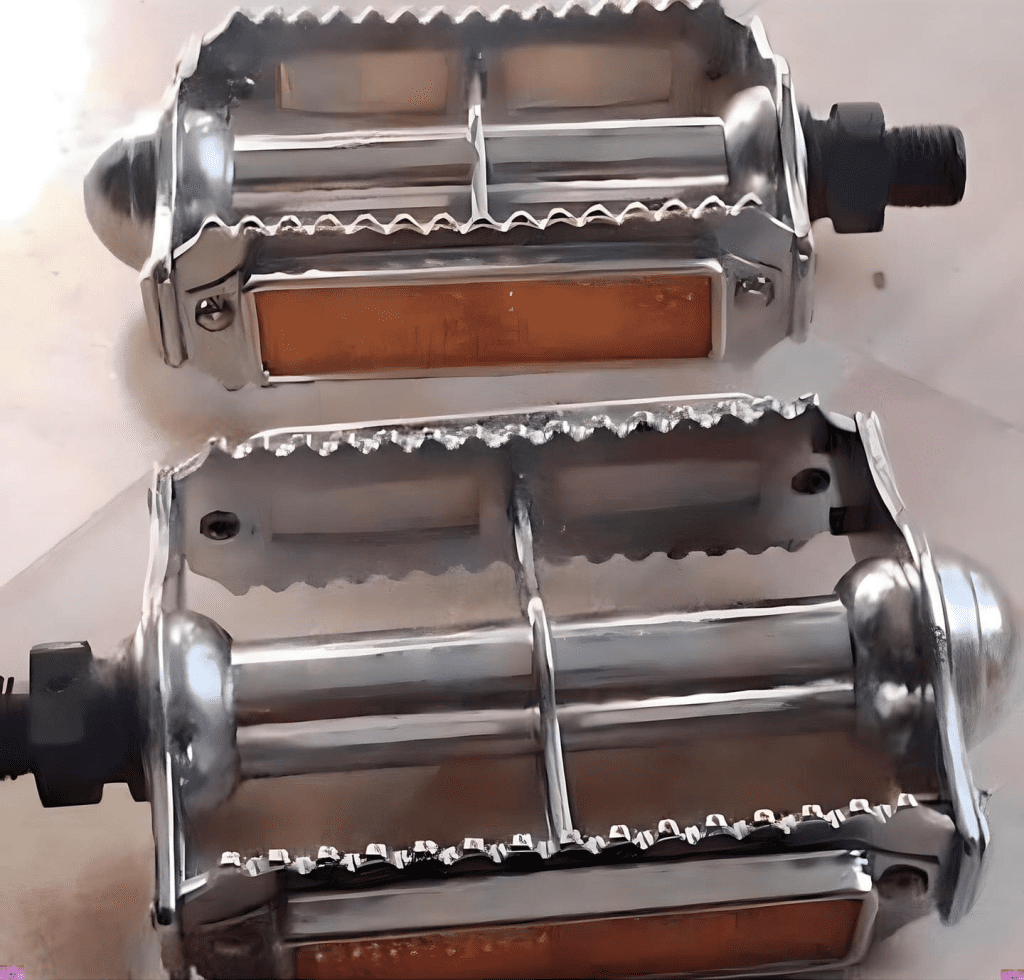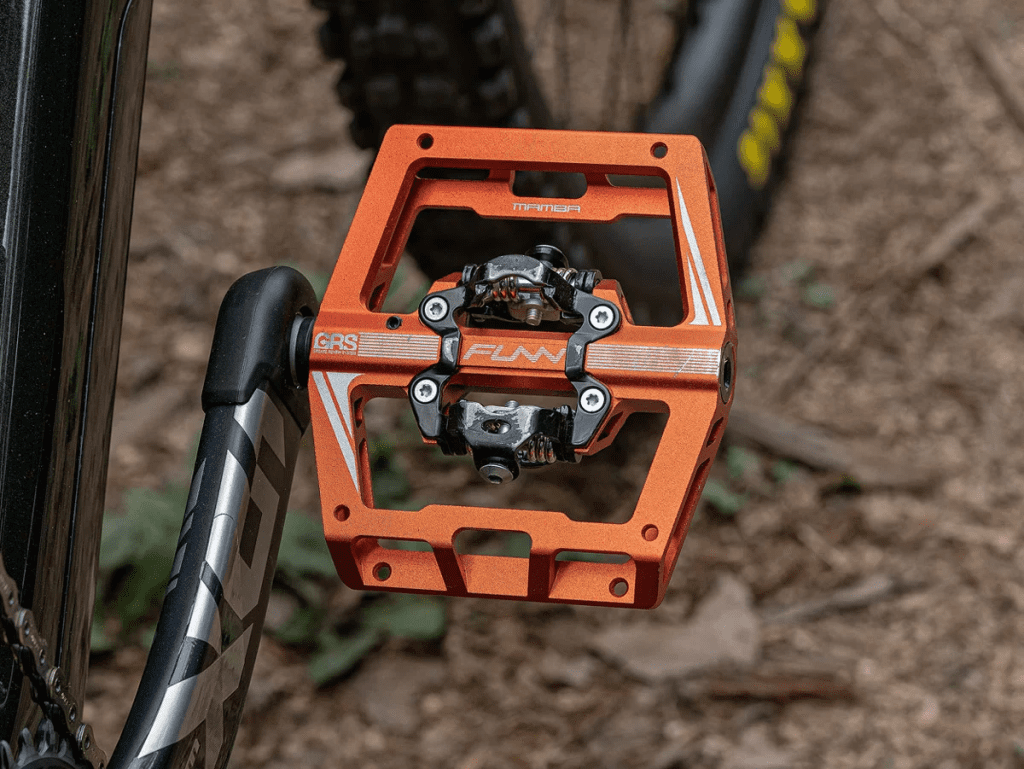The bicycle pedal is one of the most crucial components of a bicycle, directly responsible for converting the rider’s effort into motion. Serving as the contact point between the cyclist’s foot and the crank, pedals are integral to propelling the wheels forward and ensuring a seamless riding experience. Over time, pedals have evolved from simple platforms to technologically advanced systems designed for efficiency, control, and versatility.
This article delves into the fascinating world of bicycle pedals, their types, functionality, and how they cater to various cycling disciplines.

The Basics of Bicycle Pedals
Bicycle pedals act as the interface where the rider applies force to turn the crank, propelling the bike forward. The pedal system consists of a spindle that connects to the crank arm and a rotating body where the foot rests. Modern pedals are designed with bearings to allow smooth rotation, reducing friction during pedaling.
Pedals play a significant role in cycling ergonomics, efficiency, and safety. Choosing the right pedal type depends on the rider’s preferences, cycling style, and terrain.
Evolution of the Bicycle Pedal
From Simplicity to Sophistication
The earliest pedals were directly attached to the cranks on the driven wheel. As bicycles evolved, the advent of the safety bicycle introduced a chain-driven system where pedals were connected to the rear wheel via a sprocket and chain.
The simplicity of early pedals gave way to innovative designs aimed at improving grip, efficiency, and power transfer. Modern designs incorporate advanced materials and mechanisms, catering to specific cycling needs, from urban commuting to competitive mountain biking.
Types of Bicycle Pedals
Bicycle pedals come in various forms, each designed to suit different cycling styles and terrains. Here’s an in-depth look at the most popular types:
Flat and Platform Pedals
Flat or platform pedals provide a wide, flat surface for the foot to rest on, making them ideal for casual riders and beginners. These pedals are easy to use and allow quick foot removal, enhancing safety in unpredictable situations.
- Advantages:
- No special shoes required.
- Suitable for casual rides and urban commuting.
- Durable and budget-friendly options available.
- Common Uses: BMX, mountain biking, and everyday commuting.

Quill Pedals
Quill pedals are traditional designs featuring a spindle, a platform, and a cage structure. Often paired with toe clips and straps, these pedals provide additional foot stability and are popular in vintage cycling circles.
- Key Features:
- Toe clips prevent the foot from slipping.
- Suitable for road and touring bicycles.
- Requires manual adjustment for optimal fit.
Clipless Pedals
Despite the name, clipless pedals eliminate the need for traditional toe clips, relying instead on a cleat system that locks the shoe to the pedal. Introduced in the 1980s, clipless pedals revolutionized cycling by improving power transfer and reducing foot slippage.
- Advantages:
- Enhanced pedaling efficiency.
- Secure foot placement.
- Ideal for both road cycling and mountain biking.
- Popular Variants: SPD (Shimano Pedaling Dynamics) for mountain biking and Look Delta for road cycling.
Materials and Build Quality
Pedals are crafted using materials that balance durability, weight, and grip. Common materials include:
- Aluminum and Steel: Found in budget-friendly models, offering durability but adding weight.
- Magnesium: Lightweight and strong, often used in high-end downhill pedals.
- Nylon and Polycarbonate: Lightweight and cost-effective, suitable for BMX riders and beginners.
Premium pedals may feature replaceable metal traction pins and sealed cartridge bearings for longevity and performance.
Choosing the Right Pedal
Selecting the right pedal depends on the rider’s discipline, terrain, and personal preferences.
For Mountain Biking
- Opt for platform pedals with metal pins for better grip in wet and muddy conditions.
- Clipless pedals are ideal for enhanced control on technical trails.
For Road Cycling
- Clipless pedals offer superior power transfer and efficiency during long rides.
- Lightweight designs with minimal float ensure a streamlined experience.
For Urban Commuting
- Flat pedals are versatile and compatible with regular footwear.
- Models with built-in reflectors enhance visibility during nighttime rides.

Innovative Features in Modern Pedals
Float and Tension Adjustments
Modern clipless pedals provide float adjustments, allowing slight rotational movement of the foot. This feature reduces knee strain and improves comfort.
Platform Adapters
For riders transitioning to clipless systems, platform adapters offer the flexibility to use regular shoes temporarily. These adapters snap onto clipless pedals, providing a flat surface for the foot.
Traction Pins
High-end platform pedals come equipped with replaceable traction pins, ensuring a firm grip even in slippery conditions.
Maintenance Tips for Long-Lasting Pedals
Proper maintenance ensures your pedals perform optimally for years. Here are some essential tips:
- Regular Cleaning: Remove dirt and debris after each ride, especially if cycling in muddy terrain.
- Lubricate Bearings: Smooth rotation depends on well-lubricated bearings. Apply grease periodically to prevent wear.
- Check for Wear: Inspect pedals for worn-out traction pins, damaged cleats, or loose bearings. Replace components as needed.
- Tighten Connections: Ensure the pedal spindle is securely threaded into the crank arm to prevent accidents.
Bicycle Pedals: Combining Form and Function
The evolution of bicycle pedals reflects the ingenuity of cycling technology. From the simple flat pedal to advanced clipless systems, modern pedals cater to a wide range of cycling needs, enhancing both performance and safety.
Whether you’re an avid road cyclist, a mountain biking enthusiast, or a casual commuter, the right pedals can make all the difference in your ride. With proper care and thoughtful selection, your pedals will serve as a reliable foundation for countless cycling adventures.
Conclusion
Bicycle pedals may seem like small components, but their impact on cycling performance is immense. By understanding the different types of pedals and their unique features, you can choose the perfect pair to elevate your riding experience.
Remember, the journey begins with a single push—so make it count with the right pedals!


